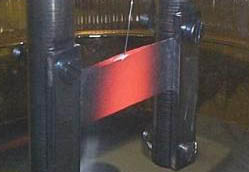Copper Pentagons

Perfect crystal structures can contain pyramids, cubes, or hexagons, but not pentagons. The five-fold symmetry of a pentagon is impossible to replicate over and over in space to make a conventional crystal. But a team reports in the 26 September PRL that copper does display five-fold symmetry–as a liquid. Liquid copper, like other metals, is not entirely disordered but forms temporary small-scale structures. X-ray experiments on thin liquid films have suggested the pentagons, and the new work confirms those findings with direct measurements on “bulk” samples. The research validates a decades-old prediction and suggests that five-fold symmetry may be widespread in liquid metals.
Most solid metals form closely packed cubic crystals, but in the 1950s, calculations showed that metals such as copper, gold, silver, and lead might form liquids with local five-fold symmetry. It was already known that atoms in a liquid could form small clusters that constantly break and reform. Five-fold ordering in metals is not entirely unprecedented. Quasicrystals are metal alloys that have a strange semi-crystalline five-fold symmetry that never quite repeats itself. But five-fold ordering in a material that is normally a perfect crystal has never been seen before.
Until recently, techniques for determining atomic structure haven’t been agile enough to test liquids, except as very thin films. Liquids have little long-range order, and their atoms move around. Also, most previous techniques could only find the relative positions of two atoms at a time, which made it difficult to pin down the five-fold symmetry prediction.
Andrea Di Cicco of the University of Camerino in Italy, and his colleagues, developed a way to find the bond angles among triplets of atoms. Only one other such technique exists, but it requires a very thin sample that may be influenced by the solid surfaces surrounding it. The Italian researchers used an x-ray beam at the European Synchrotron Radiation Facility in Grenoble, France, and the technique of x-ray absorption spectroscopy (XAS).
XAS normally determines distances between atom pairs, but the researchers extended the usual analysis to pull out more information from the data. In XAS, a photon from the x-ray beam strikes a target atom and kicks out an electron. After this electron scatters from a second, neighboring atom, researchers detect it and can learn the distance between the two atoms. But often the electron scatters off more than one atom, producing a more complicated scattering pattern. Di Cicco and his colleagues developed a way to interpret the scatter produced when the electron hits more than one atom. The researchers found that while most clusters had four-fold, cubic symmetry, about 10% were in pentagonal clusters, all of which was anticipated by the old theories.
Di Cicco and his colleagues were “extremely clever,” says Daniel T. Bowron of the Rutherford Appleton Laboratory’s ISIS facility in Oxon, UK. “They’ve taken full advantage of the strength of the x-ray absorption technique.” The results are valuable experimental evidence in a field that has previously relied on theoretical models, says Bowron. He adds that the team’s results may also give insight into the process of crystal growth, as researchers study the crystallization of a liquid with five-fold symmetry into a solid with four-fold symmetry.
–Kim Krieger
Kim Krieger is a freelance science writer in Norwalk, Connecticut.


